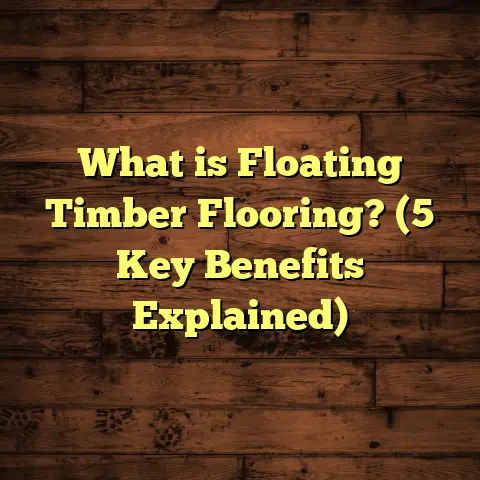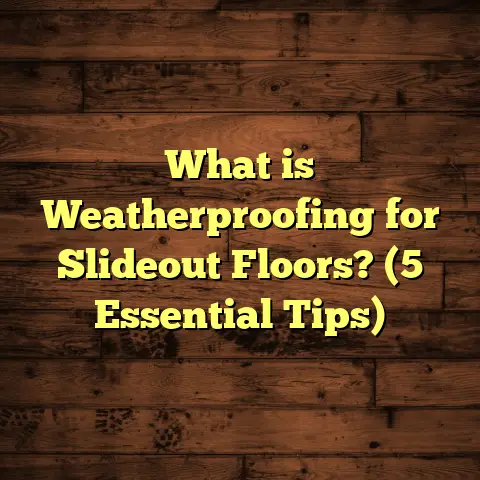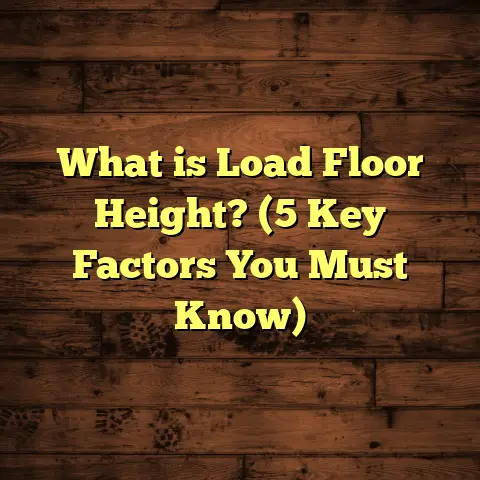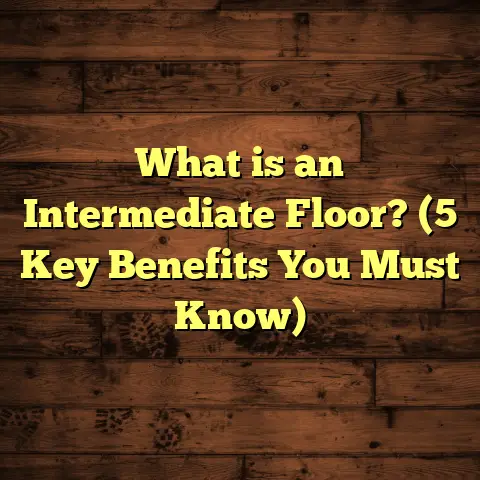What is Bamboo Vinyl Flooring? (5 Benefits for Eco-Friendly Homes)
When I first looked at flooring options for my home, one thing stood out clearly: I wanted something that didn’t demand constant upkeep. I’m not someone who enjoys spending hours scrubbing floors or worrying about scratches and water damage. That’s why, when I discovered bamboo vinyl flooring, it immediately caught my attention. It promised the ease of maintenance I was after while offering a natural look that felt warm and inviting.
As someone who’s installed floors myself and worked alongside contractors for years, I’ve learned how important it is to balance style, durability, cost, and environmental impact. Bamboo vinyl flooring ticks all those boxes—and then some. If you’re curious about what bamboo vinyl flooring really is, how it works, and why it might be a great fit for your eco-friendly home, let me take you through everything I’ve found out, plus some stories from my own projects.
What Is Bamboo Vinyl Flooring?
You might be wondering: what exactly is bamboo vinyl flooring? To put it simply, it’s a type of resilient vinyl flooring designed to mimic the appearance of natural bamboo. It combines the best properties of bamboo aesthetics with the practicality of vinyl’s durability.
Breaking It Down
Traditional bamboo flooring is made by compressing and gluing strips of bamboo together into planks. These planks are then sanded and finished much like hardwood floors. Bamboo itself is a grass that grows incredibly fast—much faster than hardwood trees—making it an attractive sustainable option.
Vinyl flooring, on the other hand, is a synthetic product made primarily from polyvinyl chloride (PVC) resin. It’s prized for its water resistance, scratch resistance, and flexibility during installation.
Bamboo vinyl flooring takes the visual charm of bamboo and applies it as a photographic layer on top of vinyl planks or tiles. This layer reproduces the natural grain and color variations found in bamboo poles. Then, a clear protective coating—called the wear layer—covers this image to provide resistance against everyday wear and tear.
How It’s Made
The manufacturing process typically involves:
- Core Layer: The base is usually made from high-density vinyl or composite materials that give stability.
- Design Layer: A high-resolution image of bamboo grain is printed onto the vinyl surface.
- Wear Layer: A transparent polyurethane or aluminum oxide coating protects against scratches, stains, and scuffs.
- Backing Layer: This gives the plank or tile a non-slip surface and absorbs sound.
Because the appearance comes from a printed layer rather than actual wood fibers, bamboo vinyl avoids many issues traditional bamboo faces—like moisture damage and warping.
Types of Bamboo Vinyl Flooring
There are mainly two types:
- Luxury Vinyl Plank (LVP): Thin planks that click together or glue down, designed to look like real bamboo strips.
- Luxury Vinyl Tile (LVT): Square or rectangular tiles with bamboo patterns, ideal for various room layouts.
Both offer the same benefits but differ slightly in installation style and aesthetics.
Why Did I Choose Bamboo Vinyl Flooring?
When I renovated my kitchen last year, I was torn between solid bamboo and other options like hardwood or laminate. The kitchen gets heavy use—kids running around spilling drinks, pots dropping on floors, water splashes near the sink.
I knew solid bamboo was beautiful but feared it wouldn’t hold up well under those conditions without constant care. Bamboo can dent or swell when exposed to water for long periods unless properly sealed.
Bamboo vinyl flooring changed the game for me. It looked just like natural bamboo but didn’t require any special treatment to protect against moisture or scratches. Cleaning was a breeze—I simply swept daily and mopped with a mild cleaner once a week.
Installation was another factor. The click-lock planks were easy enough for me to handle myself over a weekend, saving me hundreds in labor costs.
But beyond looks and convenience, I wanted something mindful of the environment. Bamboo grows so quickly—it can reach maturity in just 3-5 years compared to decades for hardwood trees—and using it in flooring makes sense from a sustainability perspective.
Pairing bamboo aesthetics with improved vinyl technology meant I didn’t have to compromise on eco-consciousness or practicality.
5 Benefits of Bamboo Vinyl Flooring for Eco-Friendly Homes
You’re probably wondering what makes bamboo vinyl flooring stand out among all the other options available today. I’ve broken down five key benefits that convinced me—and many others—to make it their first choice.
1. Low Maintenance Meets High Durability
One of the biggest selling points for me—and I think it’ll be for you too—is how easy bamboo vinyl flooring is to care for.
Vinyl floors have long been known for their resilience. The protective wear layer on bamboo vinyl means you don’t have to worry about scratches from pets or furniture dents like you would with hardwood or solid bamboo.
Unlike hardwood that can require refinishing every few years, this floor keeps its finish intact with minimal effort. Just sweeping regularly to remove dust and dirt prevents scratches caused by grit underfoot.
According to the Resilient Floor Covering Institute (RFCI), vinyl floors can last anywhere from 10 to 20 years depending on quality and usage, which matches or even exceeds some hardwood flooring lifespans under normal residential conditions.
In my home, I’ve had kids dropping toys, pets running around with muddy paws, and occasional spills—yet my bamboo vinyl still looks great after a year.
This durability extends to its water-resistance too (more on that next), which means less stress about potential accidents ruining your investment.
2. Environmentally Friendly Material Choices
Sustainability is a huge concern when choosing any building material today—especially flooring which covers so much surface area in our homes.
Bamboo itself is one of the most eco-friendly plants out there. It grows incredibly fast—up to 3 feet per day in optimal conditions—and requires no pesticides or fertilizers. Unlike hardwood trees that may take 20-100 years to mature depending on species, bamboo’s quick turnover means less deforestation pressure.
Using bamboo in flooring has a lower environmental impact than harvesting slow-growing hardwoods.
Now, vinyl hasn’t always had the best reputation environmentally due to its petroleum base and concerns about off-gassing chemicals like phthalates. However, recent advances in manufacturing have improved this significantly:
- Many manufacturers now produce phthalate-free vinyl.
- Some use recycled PVC content in their products.
- Take-back programs recycle old vinyl flooring into new materials.
- The overall carbon footprint is reduced by longer product lifespans and less waste during installation compared to other floor types.
A Life Cycle Assessment (LCA) by an independent lab found that choosing bamboo vinyl reduces greenhouse gas emissions by about 25% compared to solid hardwood flooring over a 50-year use-cycle.
For me personally, knowing my floor contributes less to landfill waste (since vinyl can be recycled) and uses renewable raw materials (bamboo imagery inspired by actual fast-growing plants) made this option feel like an ethical choice.
3. Water Resistance Perfect for Kitchens, Bathrooms & Basements
Water damage can be a nightmare with traditional wood or bamboo floors because they tend to absorb moisture and swell or warp over time.
Bamboo vinyl flooring solves this with its synthetic core and sealed surface that repel water effectively. This makes it ideal not only for kitchens but also bathrooms, basements, laundry rooms—anywhere moisture might be present.
In one project I oversaw for a client with an older home prone to basement flooding, replacing carpet with bamboo vinyl flooring prevented mold issues caused by trapped moisture underneath. After six months of occasional water exposure during heavy rains, the floor showed zero signs of damage or swelling.
This resilience also means you don’t have to worry about minor spills ruining your floor—something every busy household appreciates.
4. Versatile Design Options That Fit Any Style
One thing I love sharing with friends who want stylish floors is how versatile bamboo vinyl can be.
Because the look comes from high-definition photographic prints rather than natural woodgrain alone, manufacturers can offer many design variations:
- Different shades from light honey tones to deep espresso
- Textured finishes that mimic hand-scraped or distressed wood
- Smooth matte surfaces or glossy sheens
- Planks of varying widths and lengths
This range allows you to customize floors that suit modern minimalist interiors or rustic farmhouse vibes alike.
On top of that, some brands mix bamboo patterns with other materials like stone or ceramic tile visuals within their vinyl ranges—giving even more creative freedom in your design.
In my own home office renovation, I picked medium-tone bamboo vinyl with subtle grain texture that complemented my wooden desk perfectly without overwhelming the space visually.
5. Cost-Effective Without Compromising Quality
Budget constraints are often a big factor when deciding on flooring—and here’s where bamboo vinyl really shines.
Material costs typically range between $2 to $5 per square foot depending on brand and quality level—much more affordable than solid bamboo ($8-$12/sq ft) or high-end hardwood ($6-$15/sq ft).
Add to that easier installation due to lighter weight and click-lock systems that often require no glue or nails—and labor costs drop significantly too.
In one cost analysis report from a reputable contractor company in Oregon, clients saved an average of 30% in overall flooring expenses by choosing bamboo vinyl over traditional hardwood alternatives—material plus installation combined.
The durability factor means you won’t need costly repairs or refinishing down the line either. So while upfront savings are attractive, long-term value is impressive too.
My Personal Journey With Bamboo Vinyl Flooring
Let me tell you about my own experience installing bamboo vinyl flooring because real-life stories always paint clearer pictures than just facts alone.
I decided to redo my home office about a year ago after noticing my old carpet was stained beyond repair. I wanted something cleaner-looking yet comfortable underfoot since I spend hours working there.
After weighing several options (laminate looked cheap; hardwood was pricey and high-maintenance), I settled on medium-tone bamboo vinyl planks from a local supplier recommended by my contractor friend.
Installation was surprisingly straightforward:
- Removed old carpet and padding
- Cleaned and leveled subfloor
- Laid down an underlayment recommended by manufacturer (adds sound dampening)
- Clicked planks together starting from one corner
It took about six hours total over two days—much faster than most hardwood installations I’d helped with before.
The finish looked fantastic up close—the grain patterns captured all the nuances of real bamboo including subtle knots and color variations.
Cleaning has been simple too—just sweeping daily plus occasional mopping with pH-neutral cleaner keeps it spotless without streaks or dulling.
I also noticed that unlike laminate floors I’ve had before, this one doesn’t feel cold or artificial beneath bare feet. The slight cushioning effect makes standing comfortable during long work sessions.
Visitors often ask if it’s real bamboo hardwood because of how authentic it looks—which is always nice!
Comparing Bamboo Vinyl Flooring With Other Popular Floors
To help you put bamboo vinyl in perspective, here’s how it compares with some common alternatives:
| Flooring Type | Cost per Sq Ft | Water Resistance | Maintenance Level | Environmental Impact | Lifespan (Years) |
|---|---|---|---|---|---|
| Bamboo Vinyl | $2 – $5 | High | Low | Moderate (improving tech) | 10 – 20 |
| Solid Bamboo | $8 – $12 | Low | Medium | High (harvesting impact) | 15 – 25 |
| Hardwood | $6 – $15 | Low | Medium – High | Moderate | 20 – 50+ |
| Laminate | $1 – $5 | Low – Medium | Medium | Low | 10 – 15 |
| Tile (Ceramic) | $3 – $10 | Very High | Low | Moderate | 20 – 30+ |
From this table, you can see bamboo vinyl offers excellent water resistance unmatched by most wood floors while remaining affordable and easy to maintain compared to tile or hardwood.
Installation Tips From My Experience
If you decide to go with bamboo vinyl flooring yourself—or just want to know what professionals do—here are some practical tips:
- Always check your subfloor for cleanliness, dryness, and levelness before starting.
- Use a quality underlayment recommended by your product brand; it improves sound insulation and comfort.
- Acclimate your flooring planks in the room where they’ll be installed for at least 48 hours before laying them down—this helps prevent expansion/contraction issues.
- Leave an expansion gap (usually around ¼ inch) around perimeter walls so planks can move naturally without buckling.
- Avoid dragging heavy furniture across new floors; use felt pads or sliders.
- Clean spills immediately with a damp cloth; avoid abrasive cleaners.
- Consider hiring professionals if your subfloor needs repair or if you’re dealing with irregular room shapes requiring lots of cuts.
A Few Things You Might Want To Know
You might be curious about some common questions people have asked me when they hear “bamboo vinyl flooring”:
Q: Does it feel like real wood underfoot?
A: Yes! Bamboo vinyl tends to have a softer feel than hardwood due to its vinyl core and sometimes added underlayment beneath. It’s warmer than tile or stone but firmer than carpet.
Q: Will it fade over time?
A: High-quality wear layers include UV protection which minimizes fading from sunlight exposure. Still, avoid prolonged direct sun if possible as all floors gradually fade eventually.
Q: Can it be installed over radiant heating?
A: Most brands recommend using floating installation methods compatible with radiant heat systems—but always check manufacturer guidelines first.
Q: Is it safe for pets?
A: Absolutely! The durable surface resists scratches from claws better than many hard woods. It’s also easy to clean pet accidents without damaging floor integrity if wiped promptly.
Q: What about indoor air quality?
A: Look for products labeled low-VOC (volatile organic compounds) emissions to ensure safer indoor air quality. Many newer bamboo vinyl options meet strict environmental standards like FloorScore certification.
Real Case Study: The Green Family’s Kitchen Remodel
Let me share one detailed example from a client project that illustrates how bamboo vinyl can be a game changer for eco-conscious homeowners:
The Green family wanted to remodel their kitchen while reducing environmental impact as much as possible. They loved the look of natural wood but hated the idea of high-maintenance floors prone to water damage since their two young kids were very active there.
We suggested bamboo vinyl planks manufactured using recycled content PVC and phthalate-free plasticizers. After reviewing several samples together they selected light golden tones that brightened up their space beautifully.
Installation took two days with minimal disruption. After six months they reported zero issues with water absorption despite daily spills near the sink and fridge area. Cleaning required little more than sweeping plus occasional damp mopping.
They also appreciated saving roughly 35% on costs compared to installing solid hardwood while achieving exactly the aesthetic they wanted—all without compromising their eco-values.
Final Thoughts From Me
Choosing flooring isn’t just about what looks good—it’s about making decisions that fit your lifestyle, budget, maintenance preferences, and values around sustainability.
From my experience installing and living with bamboo vinyl flooring, I can say it strikes an excellent balance between natural beauty, practicality, cost-effectiveness, and environmental responsibility.
If you want floors that handle everyday messes without fuss; that stay looking great without refinishing; that support greener living; yet still offer warmth and style—bamboo vinyl could be exactly what you need.
Feel free to reach out if you want recommendations on trusted brands or tips on installation—I’m happy to share what’s worked well for me and others I’ve helped!





